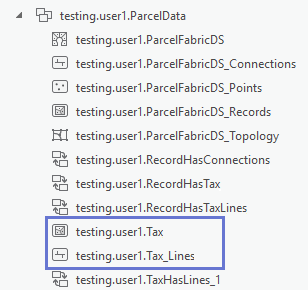Parcels are added to the parcel fabric as parcel types. A parcel type is composed of a polygon and line feature class and is defined by your organization. For example, your organization may manage both ownership/tax parcels and subdivision parcels. You can add as many parcel types as necessary for your organization.
Use the Add Parcel Type geoprocessing tool to add a parcel type to the parcel fabric. Right-click a parcel fabric in the Catalog pane, point to Manage, and click Add Parcel Type  to load the Add Parcel Type geoprocessing tool.
to load the Add Parcel Type geoprocessing tool.
The tool creates a polygon and line feature class and adds the parcel type feature classes to the geodatabase topology.

Parcel types work as follows:
- Both the parcel type polygon and the line feature are associated with the parcel record.
- Parcel data is loaded into the parcel fabric by appending parcel features to the parcel type feature classes.
- Parcel types can store administrative boundaries.
- Parcel types can be z-aware and can store stacked strata of parcels (condominiums, apartments, flats, units).
Parcel types can have their own behavior, which is defined by schema (attribute fields and related tables) and a combination of geodatabase topology rules and attribute rules. For example, rules can be configured to allow certain parcel types to overlap and other parcel types to not overlap.
Use the Remove Parcel Type geoprocessing tool to unregister a parcel type from the parcel fabric. The parcel type feature classes can be deleted.
Boundaries
A single shared line is used to represent adjacent parcel boundaries when the following conditions are met:
- The adjacent boundaries have matching dimensions and lie between the same points.
- The adjacent boundaries belong to the same parcel type.
Overlapping lines are used in the following circumstances:
- The adjacent, coincident boundaries show different dimensions.
- The adjacent boundaries do not lie between the same points, for example, a right-of-way boundary line that is adjacent to a series of parcels.
- The adjacent boundaries belong to different parcel types.
Parcel lines are associated with the record that created them. The Created By Record field of a parcel line is populated with the Global ID of the associated record from the Records table.
When merging, splitting, or constructing parcels, if parcel line dimensions are unchanged from their original parcel record, the lines remain associated with their original parcel record. Parcel lines remain associated with the record that originally created them until a newer parcel record redefines the dimensions of the line (changes the line). This can result in parcel polygons being defined by lines that are associated with different records. This allows you to identify changes in a parcel record and to track line history by recorded dates.
Administrative parcels
Parcel types can store administrative parcels. Administrative parcels are used for very large parcels such as country parcels or state parcels. To add a parcel type that uses administrative parcels, choose Use for administrative boundaries on the Add Parcel Type geoprocessing tool.
If a parcel type uses administrative boundaries, the parcel type polygon feature class is excluded from the geodatabase topology.
Strata parcels
Parcel types can store strata parcels. Strata parcels represent floors above and below the ground and are also known as condominiums, units, apartments, flats, basements, and vertical parcels. There are many different names used for strata parcels depending on the country.
To enable a parcel type to store strata-based parcels, add the following field to both the parcel type lines and polygon feature class:
| Field name | Type |
|---|---|
FloorOrder | Long |
The FloorOrder field works as follows:
- The field is populated with an integer value that denotes a floor level, for example, -2, -1, 0, 1, 2, 3.
- The same floor order value must be populated in both the parcel lines and polygon feature class for the parcel to be recognized as a floor level.
- The field can have Null values. Parcels with Null values in their FloorOrder fields are assumed to be at the same level.